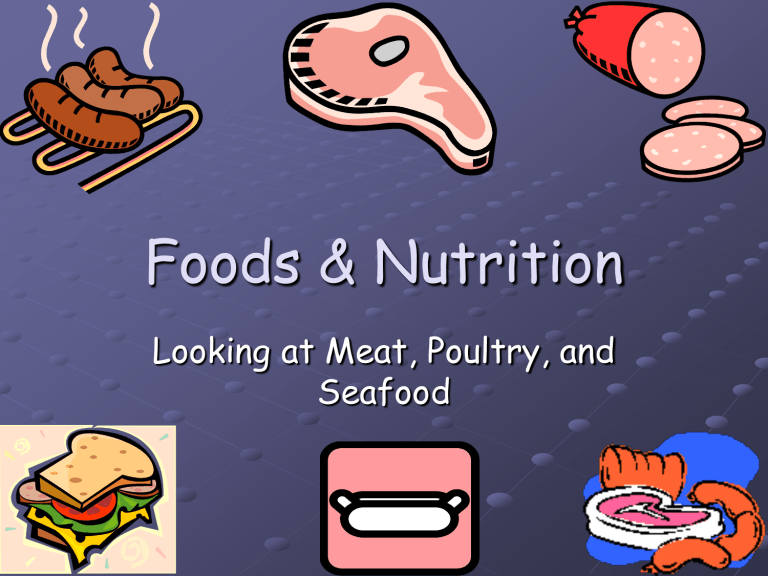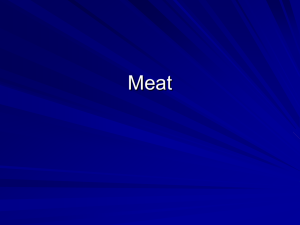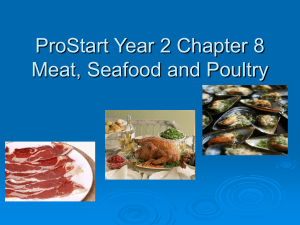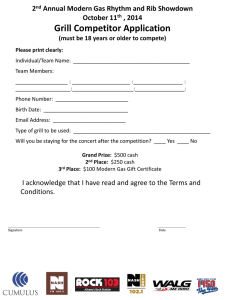Foods & Nutrition

Foods & Nutrition
Looking at Meat, Poultry, and
Seafood
Nutrition
Food Guide Pyramid
2-3 servings a day
1 serving = 2-3 oz.
Excellent sources of complete protein
All provide B vitamins, phosphorus & certain trace minerals
Meat & Poultry
Iron & Zinc
Fish
Omega-3 essential fatty acids
Nutrition
Cholesterol
All animal muscle contains about the same amount of cholesterol per ounce
Fat
content varies
Types of fat
Meat & Poultry
Invisible fat- within the chemical composition of the food
Visible fat
Marbling w/in the muscle tissue of the meat
Makeup of Meat & Poultry
Have very long, thin muscle cells
Thinnest in young animals
Thickest in older animals and those parts of the body that get a lot of exercise
The thicker- the tougher
Connective Tissue- protein material that surrounds cells
Collagen- thin, white or transparent; when cooked turns into a gelatin
Elastin- tough, yellowish; tenderizing methodspounding, cutting or grinding
Makeup of Fish
Very short fibers arranged in layersflakes when cooked
Separated by thin, fragile connective tissue
When heated- gelatin
Fish & Shellfish-----very tender
Types of Meat
Beef
Cattle, more than 1 year old
Bright red flesh
Veal
Calves, 1-3 months old
Mild flavor, light pink color, little fat
Lamb
Young sheep
Mild but unique flavor
Bright pink color w/ white brittle fat
Pork
Meat from hogs
Grayish pink color w/ white fat
Cuts of Meat
Wholesale cuts
large cuts for marketing
Basically is the part of the animal the meat came from
Listed 2 nd on label
Types of Cuts
Retail Cuts
Smaller cuts (supermarket)
Specific to the meat you are buying
Listed 3 rd on label
Label
Bone Shapes
Wholesale cuts have distinctive bone shape
Nearly identical in all
4 types
Clues to the tenderness of the meat
Lean Cuts
Lean
Less than (based on 3.5 oz. serving)
10 grams of fat
4 grams of saturated fat
95 milligrams of cholesterol
Appearance
Less than ¼ in. fat around meat
Beef Roasts & Steaks: round, loin, sirloin, chuck arm
Pork Roasts & Chops: tenderloin, center loin, ham
Veal Cuts: all except ground veal
Lamb Roasts & Chops: leg, loin, fore shank
Ground Meat
Beef trimmings
Law- cannot contain more than 30% fat by weight
Different types sold- leaner ($$$)
You may ask to have meat ground up for you at the store (If not available)
Lamb, pork, veal
Inspection & Grading
USDA
Stamped w/ harmless vegetable dye
Meat
Graded according to:
Marbling (internal fat w/in the muscle tissues)
Age of animal
Texture and appearance of meat
Common grades of beef:
Prime
Well marbled, tender, flavorful, $$$
Choice
Most common, less marbling than prime but still tender
Select
Least amount of marbling, least expensive
Lamb & Veal
Same as beef w/ “good” replacing “select”
Pork
Not graded due to uniform quality
Storing Meat
Refrigeration/Freezer
Ground Meat-
refrigerator 1-2 days
freezer 3-4 months
Fresh Meat-
refrigerator 3-4 days
Freezer 6-9 months (beef can be stored to
12 months)
Processed Meat
Processed for distinctive flavor
Types:
Ham, bacon, sausage, cold cuts
Curing
Placing the meat in a mixture of salt, sugar, sodium nitrate, potassium nitrate, ascorbic acid and water
Smoking
Liquid smoke for flavoring
Drying & Salting
Preserves meat
Combo
Bacon- cured and smoked
Chipped beef- dried, salted and smoked
Preparing Meat, Poultry, Fish &
Shellfish
Cooking
Color
Red to brown
Pink to white
Flavor
Heat creates chemical reactions w/ in the cut
Texture
Heated meat loses fat and moisture—shrinks
Muscle fibers get firmer
Connecting tissue becomes more tender
Moist Heat
Less tender cuts
Methods
Simmering
Stewing
Braising
Overcooking- mushy meat, loses flavor
Marinating Meat
Marinade-
steeping in a liquid
Tenderizing
Adding flavor to meats
3 basic ingredients
Oil, an acid, seasonings
Using marinades
Fish- 30 minutes to an hour
Meat and poultry- 6-8 hours (30 min. for some flavor is good)
To cook:
Drain food from marinade
Make a separate batch to baste with
Cooking Meat
Thaw any frozen meat
Clean meat
Rinse w/ cold water & pat dry
Trimming the fat
Moist heat- remove skin from poultry
Dry heat- leave skin on while cooking to prevent drying out
Using a meat thermometerinsert into thickest part of meat, away from bones & fat
Fish- “10 minute rule”
(10 min. for every inch in thickness)
Doneness
Cooking Methods
Roasting or Baking
Broiling
Poaching
Microwave
Pan-fry
Stewing
Braising
Stir-frying
Poultry
Chicken
Chicken-
Light meat- leaner and milder flavor; breasts and wings
Dark Meat- more oxygen in this part of meat
(more myoglobin) which causes dark color; legs and thighs; higher in fat
Purchasing Chicken- whole, cut up, or in specific parts
“Fresh”- never been chilled below 26 F
“Hard Chilled”- chilled between 0 F and 26 F
“Frozen” or “Previously Frozen”- has been chilled to below 0F
Chicken
Broiler-fryer
Most tender & most common
Roaster
Larger & older than broiler-fryer
Yield more meat per pound
Stewing
Older, mature birds
Less tender----must use moist cooking methods
Rock Cornish game hens
Young, small, special breed
One bird= one serving (Mid-evil Times)
Capons
Desexed roosters under 10 months old
Tender & flavorful, best roasted
Turkey
Larger than chickens and have a stronger flavor
Roasting- most common cooking method
The different type of turkeys are categorized by size:
Beltsville or Fryer-roaster-
Smallest type of turkey
Average weight 5-9 lbs.
Least available type of turkey
Hen-
Female turkey
Average weight 8-16 lbs.
Tom-
Male
Up to 24 lbs.
Ducks & Geese
Ducks and Geese-
All dark meat
Flavorful yet high in fat
Usually only sold as whole & frozen
Ground Poultry
Healthy eating
Ground Chicken or Turkey
“Ground Turkey Breast” or “Ground Chicken”both meat and skin
“Ground Turkey Breast Meat” or “Ground
Chicken Meat”- only meat (no skin)
Can be substituted for ground beef- healthier yet drier (add more liquid/seasoning)
Giblets
Edible poultry organs
Liver, gizzard (stomach), and heart
Usually removed, packaged, and stuffed inside bird
Inspecting & Grading
USDA- United States Department of
Agriculture
Grade may appear on the package or attached to the wing of the bird
Grade A, B, or C
Grade A is the most common found in supermarkets—
Practically free of defects
Good shape and appearance
Meaty
Buying & Storing Poultry
Look for poultry w/ good appearance
High Quality Characteristics: plump, meaty, smooth and soft skin, well distributed fat, no tiny feathers, no bruises
Boneless pieces are more expensive
Store in refrigerator for 1-2 days
Freeze for longer storage
Seafood
Seafood
Seafood- edible finfish and shellfish
Types and Market Forms of Fish and
Shellfish:
Finfish- have fins, a bony skeleton, and a backbone
Shellfish- no fins or bones but have a shell
Freshwater Fish- Inland waters such as lakes, ponds, and rivers
Saltwater Fish- (seafood) Waters such as oceans and seas
Today many fish farms are able to raise both
Types of Fish
Light color, mild flavor, and tender texture:
Catfish, Cod, Flounder, Haddock, Halibut,
Perch, Pike, Pollock, Pompano, Red Snapper,
Sole, Trout, Turbot, Whitefish
Dark color, more pronounced flavor, and firm texture:
Bluefish, Mackerel, Salmon, Swordfish,
Tuna
Market Forms of Fish
Drawn- Whole fish w/ scales, gills, and internal organs removed
Dressed or Pandressed- “Drawn” fish w/ head, tail, and fins removed
Filets- Sides of fish cut lengthwise away from bones and backbone (usually boneless)
Steaks- Cross sections cut from large dressed fish (may contain bones)
Shellfish
Mild, sweet flavor
Mainly found in oceans and seas but some from freshwater
Two types- crustaceans & mollusks
Crustaceans- long bodies w/ jointed limbs/ covered w/ shells
Crabs- Round shell, eight legs, two claws; sold live, cooked, or frozen
Crayfish- (freshwater) “crawfish” look like small lobsters
Lobster- long, jointed body w/ 4 pair of legs & 2 lg. Claws, all covered w/ a hard shell
Average weight is 1 ¼ lb.- 2 ¼ lb.
Fresh lobster is sold and cooked live
Maine is the most popular place for fresh lobster
Shrimp- vary in size and color, usually sold frozen or previously frozen, raw or cooked
Mollusks- soft bodies covered by at least 1 shell
Clams
Mussels
Oysters
Scallops
Squid (calamari)
Inspection & Grading
FDA- Food and Drug Administration &
National Marine Fisheries Service of the US Dep’t of Commerce
Buying & Storing Fish & Shellfish
Buy from a reliable source
Display of fish
Be sure that ice is covering all of the fish
Ready-to-eat fish should not be directly next to fresh fish
Appearance and aroma
Fresh fish- shiny skin & mild aroma/ skin should spring back when touched
Shellfish- must be live to be fresh
If fish smells “fishy” it is
NOT good
Store fish in refrigerator
(1-2 days) or freezer immediately
Do not put saltwater shellfish in fresh water
Market Forms….
Fresh- HOW FRESH IS FRESH???
Frozen- usually sold as filets/ must thaw in refrigerator
Canned- tuna, salmon (oil vs. water)
Cured- smoked, pickled, salted
Foods & Nutrition
Looking at Meat, Poultry, and
Seafood








